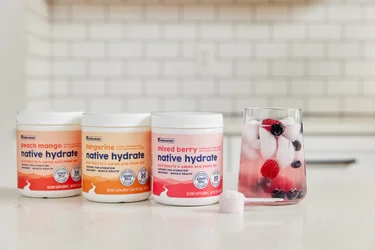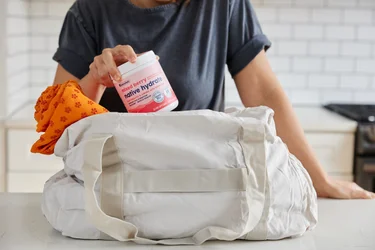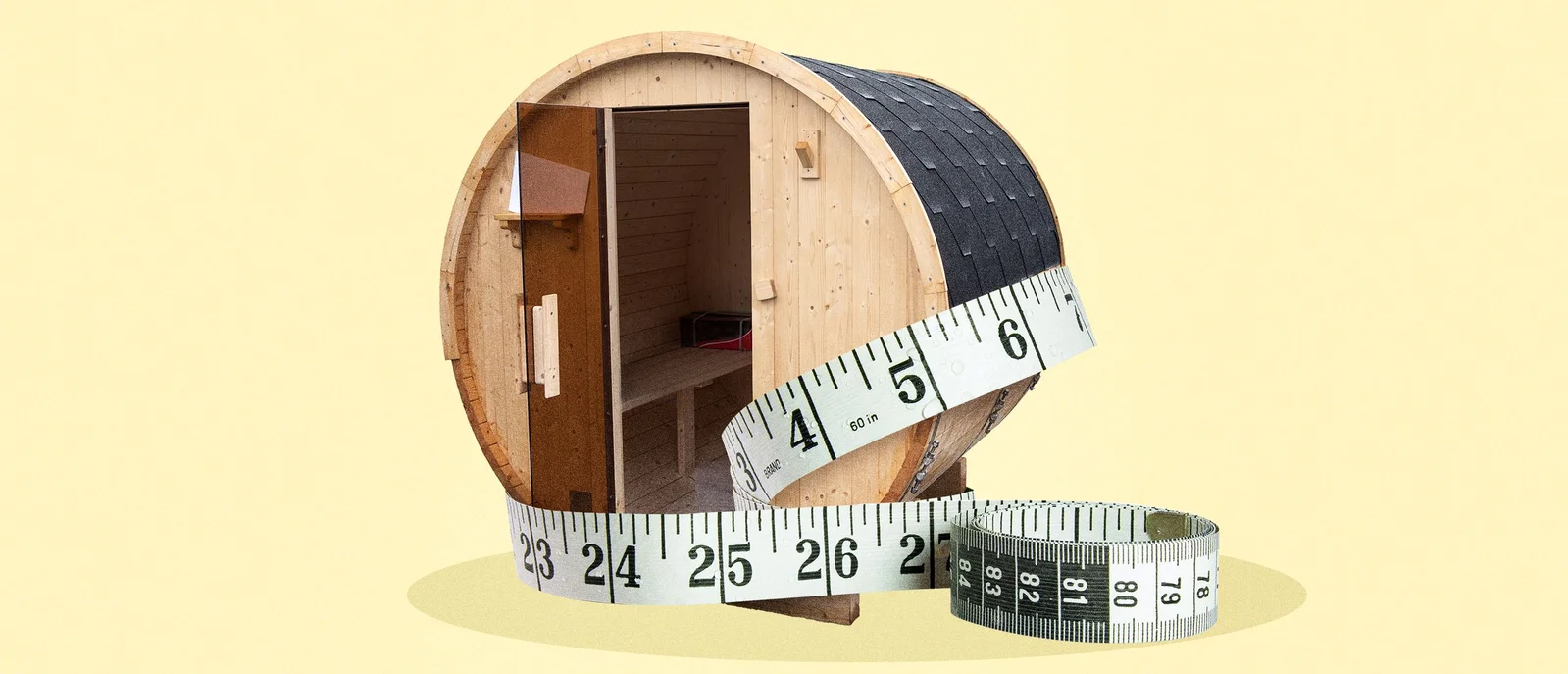As a nutritionist that works with athletes in weight-based sports (boxers, wrestlers, and mixed-martial artists), it’s safe to say that I’ve spent a lot of time in saunas. And in that time, I’ve seen firsthand the weight loss achieved through saunas. However, it may not be the type of “weight” you want to lose.
Health
Can 20 Minutes in the Sauna Help You Lose Weight?
Updated on April 26, 2024
What Does the Research Show?
A sauna can cause weight loss of 2 to 5 pounds in a single 20 minute session (1). Not bad. But before you say “sign me up!”, there’s one catch: Those lost pounds aren’t belly fat melting off…they’re water weight that’s being sweated out. Which means you’ll regain them as soon as you rehydrate.
I see this kind of weight loss all the time in athletes who are preparing for competition. Many of them rely on rapid water weight loss from saunas. But this extreme approach comes with huge health risks (think: heat stroke, cardiovascular problems, hormonal imbalances, increased risk of kidney disease, bone loss, and a suppressed immune system) (2, 3).
I’ll also note that this “weight cut”, as it's commonly referred to, should be done under the care of a professional. It’s meant to get an athlete down to a certain weight just long enough for them to step on a scale and get cleared for competition. After weighing in—and after properly rehydrating—they usually weigh as much, if not more, than they did before the sauna weight cut.
So, yes…you can lose weight by spending 20 minutes in the sauna. But weight loss shouldn’t be your primary motivation for getting your sweat on. There are seven (better) benefits you can look forward to instead.

Hydrate Smarter, Not Harder
Native Hydrate is a zero-sugar electrolyte and BCAA drink mix that combines 14 vitamins and minerals, all 9 essential amino acids, and 2,000 mg of BCAAs into one convenient scoop.
7 Other Sauna Benefits That Aren’t Weight Loss
Raising your body's core temperature comes with its fair share of health benefits. Here are seven that science has proven so far…
Production of Heat Shock Proteins
This is by and far the most important benefit you receive from a sauna. Heat shock proteins (HSPs) are a group of proteins that help protect your cells from stresses such as environmental changes, temperature, and infections (4).
By sitting in a sauna, you’re essentially putting your body under stress (yes, even if you feel relaxed). This stress prompts your body to produce HSPs to protect your cells.
The following health benefits can be achieved through the increased production of heat shock proteins:
- Prevention of Alzheimer’s and dementia (5)
- Increased immune response (6, 7)
- Reduced inflammation (8, 9)
- Insulin regulation (decreased insulin resistance and increased insulin sensitivity) (10)
Heat Acclimation
According to Jordan Sullivan, one of Australia’s leading Performance Dietitians, heat acclimation is “the process by which someone exposes themselves to thermal stress (heat) in order for their body to become better at handling the heat.”
Sullivan says that through heat acclimation, “sweat glands become better at reabsorbing electrolytes and your kidneys become better at retaining sodium, so less sodium is lost for a given activity.” He goes on to note that, “You also have greater preservation of plasma volume in your blood which means you have less cardiovascular strain in the heat.”
So what does this mean exactly? It means your body starts to become more efficient in the heat (this is especially beneficial in the summer or if you live in a warm climate). You lose less electrolytes when you sweat and your heart doesn’t have to work as hard.
When asked about how long it takes to start seeing the effects of heat acclimation, Sullivan says “the response is very individual and a response can be seen anywhere from 2-14 days.”
Reduces Blood Pressure
Regular sauna use has been shown to reduce blood pressure (11). Another study found that 2 sauna sessions a week over 3 months improved blood pressure in hypertensive patients.
Increases Energy
Sitting in a sauna can leave people feeling more energized, as their blood vessels relax and expand, resulting in increased circulation.
Decreases Stress
Exposing your body to extreme temperatures (hot or cold) is stressful for the body and is bound to raise cortisol levels (your body's main stress hormone). I know, it sounds counterintuitive, but bear with me. Regular sauna use can actually lead to a positive change in stress in the long-term.
This positive change is called hormesis, the adaptive response of cells and organisms to a moderate, usually intermittent, stress (12). Think—short-term pain, long-term gain. So as your body becomes acclimated to the sauna, cortisol levels actually lower (13, 14).
Increases Mood
Going off that, scientific studies have also shown that sauna sessions increase the production of serotonin and endorphins. When the body is under heat stress, the body responds by producing more endorphins, more endorphin receptors, and increasing the sensitivity of the receptors (15). This means that you can get more pleasure from everyday activities, like gardening or playing with your grandkids.
Chronic Pain Relief
Saunas may also help those with chronic pain and arthritis. This is because the increased blood flow can help reduce tension in the joints and relieve sore muscles.
A study in people with chronic musculoskeletal diseases, including rheumatoid arthritis and ankylosing spondylitis (a type of arthritis that affects the spine), discovered that sauna sessions improved pain, stiffness, and fatigue over the course of 4 weeks. Another study found that saunas are beneficial for lower back pain (16).
Precautions to Take When Using a Sauna
Saunas are generally safe for most people. But like most things, it's best to take precautions and seek the advice of a healthcare professional before partaking.
Here are some precautions you should take if you plan on using a sauna:
- Start slow and work your way up to regular sauna use as your body adjusts to the heat.
- Don’t have the sauna too hot, the temperature should be between 150-175 degrees Fahrenheit.
- Limit sessions to 15 to 25 minutes.
- Avoid alcohol and medications that may impair sweating and produce overheating before and after sauna use.
- Cool down gradually afterward. Drastic fluctuations in temperature can raise or lower your blood pressure rapidly.
- Make sure you are properly hydrated. Drink two to four glasses of cool water after you sauna.
- If you start to feel unwell while in the sauna, head for the door.

Water Alone Won't Cut It. This Will.
Native Hydrate is a zero-sugar electrolyte and BCAA drink mix that combines 14 vitamins and minerals, all 9 essential amino acids, and 2,000 mg of BCAAs into one convenient scoop.
Who Shouldn’t Use Saunas
Despite all the positive reasons to try it, for some people, it can be very dangerous to get in a sauna. If you fall into one of the following categories, don’t use a sauna without speaking to a doctor first.
- Have Heart Complications: If you have heart complications, the experience of a sauna can be too much for your system to take.Are Prone to Seizures: Seizure disorders either interfere with your internal temperature or can be triggered by a sudden change in temperature. If you often get seizures or are diagnosed with a seizure disorder, you should avoid going into the sauna altogether.
- Have Low Blood Pressure: Because of what a sauna does to increase circulation, if you struggle with extremely low blood pressure you should not use a sauna. It can put the body through unexpected intensity that it may struggle to handle.
- Are Pregnant: The American College of Obstetricians and Gynecologists (ACOG) states saunas are not recommended for pregnant women. Prolonged overheating can increase the risk of neural tube defects, heart defects, and oral left defects (17).
Different Types of Saunas
We’ve talked a lot about saunas in this blog, but which sauna is best for you? Here’s a list of four different options…
Wood-Burning Sauna (AKA the Traditional Sauna)
Wood-burning saunas are the most traditional type of sauna. It dates back thousands of years and extends across cultures. The two most defining characteristics of a wood-burning sauna are that it’s heated by fire and has very low humidity.
Electric Sauna
The most common type of sauna is the electric sauna, which typically uses an electric stove to heat up stones or rocks that are able to retain heat. This is the type of sauna that you would usually see at your local gym.
An electric sauna can be activated by simply pressing a button. In other words, there is no need to burn wood. Water can be splashed onto the rocks to create steam for more heat.
Infrared Sauna
A newer type of sauna is the infrared sauna which (as you might have guessed from the name) uses infrared waves as a way to heat up the body.
These waves emit infrared energy, which is on a similar wavelength to the energy that the human body naturally emits (approximately 7 to 14 microns). Infrared saunas target the body rather than warming up an entire room. As a result, the average temperature in an infrared sauna is typically much lower than a traditional sauna with a stove.
Steam Sauna
Unlike traditional saunas which have low-humidity, steam saunas (also called steam rooms) are characterized by a lot of humidity in the air—as in nearly 100% humidity. The average operating temperature in steam saunas is lower than in traditional saunas, but thanks to the high levels of humidity you will still feel the heat.
The Bottom Line
While saunas may not trim your waistline, there are plenty of other reasons why they are beneficial to maintaining a healthy lifestyle. From increased energy levels to a reduced chance of developing dementia researchers are still learning about all the benefits of sauna use.
Kat Kennedy
Kat Kennedy
NativePath has strict sourcing guidelines and relies on peer-reviewed studies, academic research institutions, and medical associations. We avoid using tertiary references.
Medical Disclaimer
This content is for informational and educational purposes only. It is not intended to provide medical advice or to take the place of such advice or treatment from a personal physician. All readers/viewers of this content are advised to consult their doctors or qualified health professionals regarding specific health questions. Neither Dr. Chad Walding nor the publisher of this content takes responsibility for possible health consequences of any person or persons reading or following the information in this educational content. All viewers of this content, especially those taking prescription or over-the-counter medications, should consult their physicians before beginning any nutrition, supplement, or lifestyle program.



